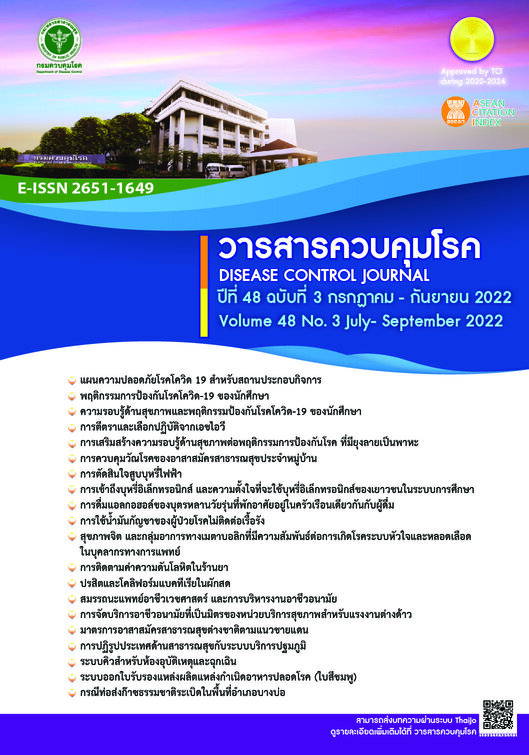Perception, attitude, accessing the electronic cigarette and intention to use the electronic cigarette among youths in education system in the Northern Region, Thailand
DOI:
https://doi.org/10.14456/dcj.2022.47Keywords:
Perception, Attitude, electronic cigarette access, Intention to use electronic cigarette, YouthAbstract
This descriptive research aimed to explore perception of, attitude toward, access to electronic cigarettes (e-cigarettes), and intention to use e-cigarette and to determine the factors associated with intention to use e-cigarettes among youths in education system in the northern region of Thailand. A total of 1,328 samples were obtained from multi-stage random sampling. A self-administered questionnaire was used for data collection. All data were analyzed using descriptive statistics, Pearson's correlation coefficient and ETA correlation. It was found that 57.4% of respondents were males, aged between 15–22 years old, and average age 16.78 years. Approximately 58.3% of them were vocational students. Only 9.1% of the youth population taking part in the study were smoking. The perception concerning e-cigarettes was at a moderate level (72.0%). Attitude on e-cigarettes was at a moderate level (77.2%). Accessibility to E-cigarette was at a moderate level (63.8%). Intention to use e-cigarettes was at a low level (74.5%). Attitude on e-cigarettes and accessibility to e-cigarette were significantly related with intention to use them at the .05 level of significance. Parents should act as a good model for the youths. In addition, teachers/lecturers should also talk to their students about the harmfulness of e-cigarettes. In the meantime, the Office of the Narcotics Control Board (ONCB) should strictly enforce the laws restricting the youth population from illegally accessing e-cigarettes.
Downloads
References
The Tobacco Products Control Act of A.D. 2017. The Government Gazette Volume 134, Part 39 A (April 5, 2017). (in Thai)
Notification of the Ministry of Commerce. Prohibition of importing Hookah and Electronic Hookah or Electronic cigarette into Thailand B.E. 2557 (A.D.2014). The Government Gazette Volume 131, Special Section 268 D (December 24, 2014). (in Thai)
Mahidol University, Tobacco Control Research and Knowledge Management Center. Tobacco Consumption Statistics Report of Thailand B.E. 2561. Bangkok: Tobacco Control Research and Knowledge Management Center; 2561. (in Thai)
Thai Health Promotion Foundation, Thai Health Center (TH). General Characteristics of Adolescents [Internet]. 2019 [cited 2019 Dec 5]. Available from: https://www.thaihealth.or.th/Content/41762 (in Thai)
King BA, Jones CM, Baldwin GT, Briss PA. The EVALI and youth vaping epidemics—implications for public health. NEJM. 2020;382(8):689-91.
Hughes K, Bellis MA, Hardcastle KA, McHale P, Bennett A, Ireland R, et al. Associations between e-cigarette access and smoking and drinking behaviours in teenagers. BMC public health. 2015;15(1):1-9.
Berg CJ, Barr DB, Stratton E, Escoffery C, Kegler M. Attitudes toward e-cigarettes, reasons for initiating e-cigarette use, and changes in smoking behavior after initiation: a pilot longitudinal study of regular cigarette smokers. OJPM. 2014;4(10):789.
Amrock SM, Zakhar J, Zhou S, Weitzman M. Perception of e-cigarette harm and its correlation with use among US adolescents. NTR. 2015;17(3):330-6.
Wayne WD. Biostatistics: A foundation of analysis in the health sciences. 6th ed. New Jersey: John Wiley & Sons; 1995.
Hinkle DE, Wiersma W, Jurs SG. Applied Statistics for the Behavioral Sciences. Michigan: Rand McNally; 1998.
Chidnayee S, Yottavee W. Factors Related with Smoking Behaviors of Youth at Uttaradit. Boromarajonani College of Nursing, Uttaradit Journal. 2018;10(1):83-93. (in Thai)
Green MJ, Gray L, Sweeting H, Benzeval M. Socioeconomic patterning of vaping by smoking status among UK adults and youth. BMC public health. 2020;20(1):183. https://doi.org/10.1186/s12889-020-8270-3.
Phetphum C, Prajongjeep A, Thawatchaijareonying K, Wongwuttiyan T, Wongjamnong M, Yossuwan S, et al. Personal and perceptual factors associated with the use of electronic cigarettes among university students in northern Thailand. TID. 2021;31(19):1-9. doi: 10.18332/tid/133640.
Jiang N, Cleland CM, Wang MP, Kwong A, Lai V, Lam TH. Perceptions and use of e-cigarettes among young adults in Hong Kong. BMC public health. 2019;19(1):1-9.
Boonpen P, Mentara P, Boonpen P. E-cigarettes Behavior and Smoking Cessation Behavior of Youth Smoker in Higher Education Institute, Bangkok. Journal of Humanities and Social Sciences. 2019;11(22):111-27. (in Thai)
Balwicki L, Smith D, Balwicka-Szczyrba M, Gawron M, Sobczak A, Goniewicz ML. Youth Access to Electronic Cigarettes in an Unrestricted Market: A Cross-Sectional Study from Poland. IJERPH. 2018;15(7):1465.
Downloads
Published
How to Cite
Issue
Section
License
Copyright (c) 2022 Disease Control Journal

This work is licensed under a Creative Commons Attribution-NonCommercial-NoDerivatives 4.0 International License.
Articles published in the Disease Control Journal are considered as academic work, research or analysis of the personal opinion of the authors, not the opinion of the Thailand Department of Disease Control or editorial team. The authors must be responsible for their articles.






